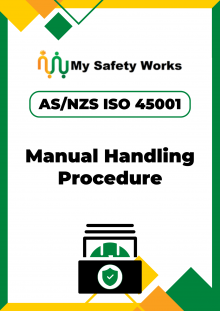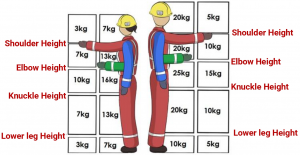
This manual handling procedure can assist your business comply with AS/NZS ISO 45001 2018, Occupational Health and Safety Management System clauses:
A manual handling task refers to workplace activities requiring the use of force exerted by a person to move, lift, lower, pull, push, hold, grasp, manipulate, strike, throw, carry or restrain an object, load or body part.
Safe manual handling refers to the correct way of lifting, pushing, pulling or carrying an object to avoid injury to yourself or the person you are helping. There are many ways to conduct safe manual handling tasks and information on safe manual handling is extensive and covers a wide range of topics however, generally, safe manual handling will focus on four key areas:
1. Assessing the weight, shape and size of the load that is to be moved.
2. The ability of the person conducting the manual handling task.
3. The importance of correct posture when conducting a manual handling task.
4. The work area where the manual handling task is being conducted.
Many workers are required to perform manual handling tasks as part of their job, and the risks associated with manual handling should be well documented and workers should be trained in safe manual handling procedures to avoid work-related musculoskeletal disorders.
Note: The best time to eliminate or minimize the risk of musculoskeletal disorders is in the design and planning stage. This is when hazards and risks can be ‘designed out’ before they are introduced into a workplace.

Safe Manual Handling Weight Guidelines
Advisory standards and codes do not prescribe absolute weight limits for lifting, lowering pushing, pulling carrying or moving loads.
You will need to risk assess the duration and frequency of the manual handling hazards and apply the highest level of control practicable.
The physical capabilities of each individual need to be considered, before attempting a manual handling task.
No person should ever attempt to lift any heavy object beyond their lifting capacity. If lifting the object appears to be too heavy seek assistance or use a mechanical aid such as a pallet jack or forklift to reduce the risks.
A ‘typical workplace’ will require many different tasks, and a great deal of these will involve manual handling. It is therefore essential that a person’s musculoskeletal system be prepared for these situations to avoid manual handling injuries or ill health. Be sure to warm up, stretch and avoid sudden movements.
When it comes to risk management, the best way to avoid injuries when manual handling is to follow a few simple rules. First, always assess the load before attempting to lift it. Make sure it is not too heavy or too awkward to lift safely. If possible, ask for help. If you must lift the load alone, be sure to use good lifting techniques, adopt a stable position, keeping your back straight and your feet shoulder-width apart. Bend your knees and grip the load close to your body.
Use your leg muscles, not your back, to lift the load. Avoid the risk of injury with awkward postures or by twisting your body while lifting. If you must turn, move your feet first, then your torso. Also, avoid lifting the heaviest side of a load first, that may increase the risk.
